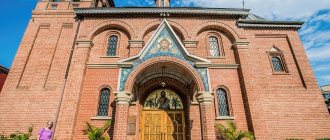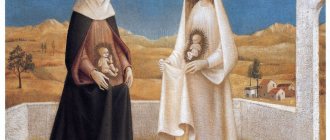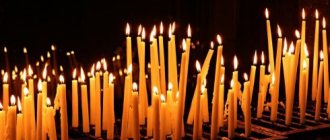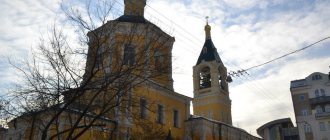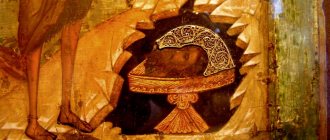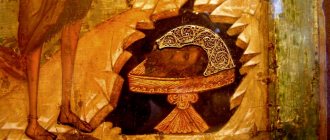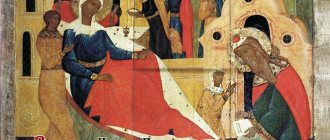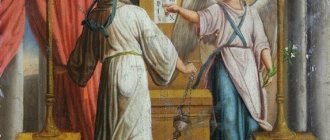John the Baptist , the great saint who Baptized the Lord.
He ended his earthly life with a martyr's death. Due to the evil slander of Herod's wife Herodias, he was brutally beheaded. She ordered that the body of the martyr be buried without a head, because she was afraid that he might be resurrected. The head of John the Baptist is the most revered part of the saint's relics. Trying to protect the shrine from desecration, they hid it. Therefore, the discovery of the head of John the Baptist is celebrated three times. The Church celebrates the first and second on March 9, and the third on June 7. The story of gaining a head is a story of loss. Some were the result of fear, others - criminal neglect and negligence. So the monks, whom the Forerunner himself ordered to keep his head, got tired of carrying it and handed over the precious burden to a fellow traveler.
Brief life of John the Baptist
One of the most revered saints after the Mother of God is the prophet John the Baptist.
He was born into the family of the priest Zechariah. On his mother's side he is a relative of Jesus Christ. John was born six months earlier than the Savior. The saint grew up in the desert, constantly praying and fasting, preparing himself for great service to the Lord. He ate locusts and wild honey, and dressed in rags. At the age of thirty, God called him to preach among the Jewish people to prepare them to accept the expected Christ. He delivered a sermon in which he preached baptism and confession for the remission of sins.
Feasts in honor of John
The famous preacher John Krestyankin said that John was so great that the Orthodox Church preserves the memory of all significant events in his life. Therefore, there are many holidays associated with it.
October 6 marks the conception of John the Baptist, July 7 - the birth of the Baptist, September 11 - the beheading of his head, March 9 - the first and second finding of the head, June 7 - the third finding of the head, October 25 - the transfer of the right hand of the Baptist from Malta to Gatchina.
Beheading of John the Baptist
The closest predecessor of Christ, who predicted the coming of the Messiah, was John the Baptist. He led an ascetic lifestyle, then preached baptism and repentance for the Jews, and baptized Christ in the waters of the Jordan.
Herodias' daughter Solome danced on Herod's birthday, for which he promised her to fulfill any of her wishes as a reward. At the instigation of her mother, she demanded the head of John the Baptist. A warrior was sent to the prison where the saint was kept with the order to behead the Forerunner. Having completed it, he brought John's head on a platter and gave it to Solomiya. She, in turn, passed it on to her mother Herodias.
Nakhodka in Bulgaria
More recently, another version of the location of the sacred relic became known. Archaeologists reported the discovery of bone remains in the ruins of a medieval monastery in southern Bulgaria in 2010. Since the monastery founded on its site was dedicated to John the Baptist, researchers suggested that these could be the remains of the saint. This was also indicated by the corresponding inscription in Greek.
Planets with hidden oceans may be suitable for life: scientists' opinion
“This is if a man doesn’t have a wife”: children answer the question of what happiness is
An epidemiologist said whether re-vaccination with Sputnik V is possible
Radiocarbon dating has established that the remains found belonged to a person who lived in the Middle East in the 1st century AD. e.
Whether this is really the head of John the Baptist is not known for certain. True, for most believers this does not matter much. Like the Holy Grail or the Shroud of Turin, the head of the saint has acquired a mythical character, so important is its role in the history of Christianity.
“There has always been a belief that if you can touch a relic associated with Jesus, it will strengthen your faith,” explains Robert Cargill, an assistant professor of religious studies at the University of Iowa. “Some are convinced that in this case they can count on a miracle.”
First discovery of the head of John the Baptist
As Church Tradition testifies, Herod’s wife Herodias did not give up the head of John so that the disciples could bury her with the body of the saint. She hid the shrine in her palace. The pious servant John knew where the shrine was located, who put it in a clay jug and buried it on the Mount of Olives. Christians passed this information among themselves until a nobleman named Innocent decided to build a temple at the burial site. During construction the chapter was discovered. Confirmation that it belonged specifically to John the Baptist was obtained through miraculous signs that emanated from the shrine. Before his death, the nobleman hid the head in the church, fearing that it would fall into the hands of the wicked. However, the location was known only to him. The temple was later destroyed.
The Story of John the Baptist
The icon of this saint should be viewed precisely through the prism of his life, which was imbued with faith and filled with various miracles that the Lord gave. The story of Saint John begins before his birth, when the appearance of the Forerunner is predicted by Saint Malachi. This fact itself is quite surprising.
There is also a separate icon of the Conception of John the Baptist, which is suitable for veneration and prayer. Including those who want to have a child or get help in childbirth turn to her. After all, John was born to elderly and childless parents.
Second discovery of the head of John the Baptist
During the reign of Constantine the Great, the head of John the Baptist was found for the second time.
Two monks arrived in Jerusalem. Appearing to one of them, John the Baptist told about the place where to look for the shrine. Having found the head, the monks placed it in a bag made of camel hair, but because of their laziness, they entrusted the Syrian potter to carry the shrine. John appeared to him and ordered him to leave the careless monks and keep the head for himself. For the rest of his life, the potter carefully guarded the honorable head, every day, lighting a lamp in front of the head. Before his death, the saint appeared to the Syrian and ordered him to place the head in a clay vessel and give it to his sister for safekeeping, who was to hand over the shrine to the Christian. Later, the head ended up in the hands of a priest, who hid it in a cave near Emessa. Later a monastery was built there. The Forerunner appeared to the archimandrite of the monastery and said where the shrine was located, after which the brethren found their head. After this she was transferred to Constantinople.
Prayer to the Forerunner and Baptist of the Lord John
Baptist of Christ, preacher of repentance, do not despise me who repents, but uniting with the heavenly ones, pray to the Master for me, unworthy, sad, weak and sad, in many ways the troubles of the one who has fallen, burdened by the stormy thoughts of my mind. Because I am a den of evil deeds, I have no end to sinful customs, because my mind is nailed down by earthly things. What will I do? We don't know. And to whom shall I resort, that my soul may be saved? Only to you, Saint John, give the same name of grace, for you are before the Lord according to the Mother of God, greater than all who were born, for you were deemed worthy to touch the top of King Christ, who takes away sins Ra, Lamb of God. Pray to him for my sinful soul, so that from now on, in the first ten hours, I will bear a good burden and accept recompense with the last. To her, the Baptist of Christ, the honest Forerunner, the extreme Prophet, the first martyr in grace, the teacher of fasters and hermits, the teacher of purity and the close friend of Christ! I pray to you, I come running to you: do not deny me from your intercession, but raise me up, cast down by many sins. Renew my soul with repentance, as with the second baptism, since you are the ruler of both: with baptism you wash away ancestral sin, and with repentance you cleanse every bad deed. Cleanse me, defiled by my sins, and force me to enter, even if nothing bad enters, into the Kingdom of Heaven. Amen.
( 7 ratings, average: 4.86 out of 5)
The Third Discovery of the Head of John the Baptist
After the exile of John Chrysostom and the associated unrest, the shrine was secretly transferred to the city of Emessa, where it remained until the beginning of the ninth century. Later, the chapter was transferred from Emessa to Comana (modern Ahazia), where it was hidden safely during the period when the iconoclastic heresy flourished.
As the legend says, after the veneration of icons was restored, at a council in Constantinople, Patriarch Ignatius, praying at night, received information about the whereabouts of the head. Emperor Michael III ordered an embassy to be sent to Comani, which discovered the shrine in the place indicated by the saint. The head was transferred to Constantinople and placed in the court church.
During the Fourth Crusade, the shrine was moved to the city of Amiens, which is located in France.
In the fifties of the last century, famous professors of medicine conducted a comprehensive pathological study of the shrine.
It was also established that the head belonged to a man who was no more than forty years old. The mark left by a sharp object is clearly visible on the shrine. It is known that Herodias, being in a state of extreme rage, pierced the head with a dagger.
Pilgrimage to the shrines of Abkhazia. John the Baptist of Christ
PILGRIMAGE TO THE SCRIES OF ABKHAZIA. Site of the Third Finding of the Head of John the Baptist
Hello, dear visitors of the Orthodox website “Family and Faith”!
In today's final publication about our pilgrimage trip to the Abkhazian village of Kamany, we will tell you about the holy place that kept the honorable head of the Forerunner and Baptist of Christ John!
Read the previous article about our pilgrimage on the website page of the Holy Martyr Basilisk of Komansky
Unfortunately , Kamany has not been completely cleared of mines. Therefore, for now, walking in the area of Orthodox shrines is only possible along paths fenced with special markers, or in cars whose local drivers know safe routes.
From Kaman you can take a short horseback ride into the mountains or take an off-road vehicle to another place revered by Christians in Abkhazia. A few kilometers from the Church of St. John Chrysostom is the site of the third discovery of the head of John the Baptist.
John the Baptist (John the Baptist) - predicted the coming of the Messiah, baptized our Lord Jesus Christ in the waters of the Jordan, and then was beheaded due to the machinations of the Jewish princess Herodias and her daughter Salome. Herodias did not allow John’s head to be buried along with his body and hid it in her palace, from where it was stolen by a pious servant and buried in an earthen jar on the Mount of Olives.
After the second discovery in the middle of the 5th century, the head of John was found and solemnly transferred to Constantinople. But when iconoclastic persecutions began, the head of the Prophet was secretly taken to Kamany (at the beginning of the 9th century), and hidden in one of the grottoes nearby the village.
After the restoration of icon veneration at the Council of Constantinople in 842, according to legend, Patriarch Ignatius, during night prayer, received instructions about the whereabouts of the holy head of the Baptist John. By order of Emperor Michael III, an embassy was sent to Kamany, which around 850 found the head of John the Baptist in the place indicated by the patriarch. After this, the chapter was transferred to Constantinople and was placed in the court church. So, for the third and last time it was found in the Abkhazian mountains.
The Kaman Grotto is revered as a sacred place for the Christian world!
The grotto looks like a small depression in the rock. Apparently the honest head of the Forerunner and Baptist John was securely covered with stones.
A miraculous image of the head of John the Baptist appeared on the wall of the cave.
The grace from visiting this holy place is poured out especially abundantly during the reading of the Akathist to the Forerunner of Christ and the singing of the troparion (the main prayer) to him.
Troparion to John the Baptist for the 3rd Finding of the Head
I come to the Divine treasure hidden in the earth, Christ opened your head to us, prophet and Forerunner. All of us, having come together in this finding, let us sing the Savior’s hymns of God, saving us from corruption through your prayers.
With Saint John the Baptist of the Savior, pray to God for us!
A visit to the holy places of the ancient village of Kamany left an indelible impression on all of us of contact with the Heavenly world! Without exaggeration we can say: there the Sky merges with the earth!
It is not for nothing that Kamana and its shrines were miraculously preserved by God from destruction. In 1992-93 The front line passed through Kamany, the surrounding villages were literally wiped off the face of the earth. But not a single shell damaged the Kaman Temple! In the stone wall enclosing the temple with a wide ring, in some places you can see shells stuck between the stones, but never exploding!..
Through the prayers of the holy glorious Forerunner and Baptist of the Lord John, the prayers of the Ecumenical Teacher and Saint John Chrysostom and the prayers of the holy glorious martyr Basilisk, help us, Lord, to be Your faithful follower and disciple! So that we, like Your saints, may carry the light of the Gospel teaching in our hearts until the end of our days, unwaveringly defending the Truth on our life path!
HOLY LAND! Pilgrim's impression
Signs and customs on the day of the celebration of the Finding of the Head of John the Baptist
- It is believed that on this day, March 9, birds return from wintering, which is a symbol of the beginning of spring. Seeing larks or storks flying in was considered a good omen - a sign of a happy and prosperous year. On this day, it was customary to make birdhouses and hang them in trees near the house.
- On this day, they pray for healing from headaches, and also asked to protect and protect children from diseases.
- There was a belief that on this day it was not recommended to go to bed before midnight. It was believed that if you fall asleep early, evil spirits could enter the house and poison or spoil the food.
- If the weather is clear on the Feast of the Finding of the Head of John, then Easter will be warm. Large snowdrifts promised a cold Easter Sunday. If the snow melts, Easter will be sunny.
- If the sky is starry at night and the moon is bright, the morning will be frosty.
John the Baptist with his life showed all believers that they need to humble their passions and strive to get rid of sins.
Why are John the Baptist and Jesus Christ called brothers?
John's mother was from the clan of Aaron and was related to the Virgin Mary. God did not give children to the married couple for a long time; they constantly prayed to him and asked for a child. When Mary found out that Elizabeth was pregnant, she hurried to her elderly relative to support her. The preacher’s mother learned that the child would be unusual, chosen by the Lord to serve him, at the first moment of her meeting with Mary, who was already carrying Christ in her womb.
As soon as the Mother of God greeted Elizabeth, the baby in her belly began to leap. He recognized and welcomed the unborn future Messiah.
The preacher was born 6 months before Jesus himself. His father was mute at that time and wished his son the name John. As soon as he wrote confirmation of this on the tablet, he immediately spoke. Which really surprised those present.
John, when he grew up, left home to serve God. He lived in the desert as an ascetic, wore clothes made of camel hair, and ate honey and locusts. When he was 30 years old, he began to walk throughout Jordan and preach baptism as a way of repentance and deliverance from sins.
All this time, John did not see Jesus, but he was sure that the Messiah would soon appear to the people. Even in his mother's womb he was filled with the Holy Spirit. Christ noted that the appearance of John was equivalent to the arrival of the prophet Elijah.
The soothsayer lived on the banks of the Jordan and baptized in water people who recognized the Lord and wanted to get rid of their sins. One day, in Bethara, Jesus himself came to John to be baptized. The Baptist was surprised and declared that he needed to be baptized by Christ, and not vice versa. During the baptism, a thunderous voice was heard from Heaven, “You are my beloved son,” and the Holy Spirit descended in the form of a dove.” Thus the Messiah was proclaimed.
